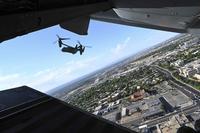The Army is refining a deliberate strategy of incremental development to address the uncertain fiscal environment of budget cutbacks, sequestration and the possibility of more continuing resolutions, service leaders said.
Army leaders are working on adjustment strategies designed to protect certain investments and could lead to the canceling of others.
Some of these strategies include leveraging commercial off-the-shelf technologies as well as incremental modernization of existing platforms, said Brig. Gen. John Ferrari, deputy director of Program Analysis and Evaluation, G8.
“We want to incrementally improve things that already exist. The development cost of improving something that already exists is not as great as the development cost of something that doesn’t exist already. Let’s prioritize the things we have and make them better,” Ferrari said in an interview with Military.com
Army leaders want to protect and preserve high-priority developmental programs such as the Joint Light Tactical Vehicle, Armored Multi-Purpose Vehicle and Ground Combat Vehicle -- however those leaders have said all programs must be reviewed because of budget cuts.
“Functioning like this is dysfunctional,” said Army Chief of Staff Gen. Raymond Odierno, speaking recently about the existing budget environment at the Association of the United States Army Annual Meeting and Exposition, Wash. D.C.
While emphasizing the importance of these and other major programs, Ferrari emphasized that science and technology investments should be preserved and protected.
“There are areas where we are technology makers. With things like armor and explosives there is not a lot of commercial sector research going on. What we want to do is focus our technology and S&T dollars into areas where we are technology makers and move that forward so that when we have money there is something there,” Ferrari said.
When it comes to rotorcraft, however, there is a sizeable commercial market that dovetails with the military, allowing for greater synergy with Army aviation platforms looking to leverage the latest available technologies, he added.
“We will keep cutting in incremental technologies into Apache, Black Hawk and Chinook over the next couple of years. There is a strategy where we are able to have savings while protecting the future,” Ferrari said.
Another example of this strategy is the Armored Multi-Purpose Vehicle, or AMPV. The service plans to engineer it with an ability to incrementally accommodate new technologies -- such as electronics, network and communication gear – as they evolve.
As a multi-mission armored vehicle, the AMPV is slated to replace the aging M113s in the Army’s current arsenal. The Army recently released a draft Request For Proposal to industry in order to solicit feedback for the platform, Ferrari said.
“It is a very non-complex system that is engineered for the applications to come in as they are needed. It will bring the Army a capability that enables it to quickly integrate new technologies into formations in a cost efficient manner as opposed to an Abrams which is really a platform that has a complex system,” Ferrari added.
As for the Abrams main battle tank, it need to have its main subsystems changed every 10 to 12 years, Ferrari said. If the AMPV is part of the same formation, and engineered for incremental growth at its inception, then perhaps it can carry the latest in Satcom technology and communications gear and link to the Abrams, Ferrari said.
“If you were able to turn the AMPV into a roving WiFi then Abrams might not need Satcom-on-the-move,” he explained.
Overall, sequestration and budget uncertainties have already impacted a range of Army priorities, including the need to reset war-damaged equipment after it returns from theater.
“Over the past year sequestration came into being and there was also an OCO (overseas contingency operation – war spending) shortfall. So the combination of sequester and the shortfall in funding for the war meant we had to take risk in certain programs – about $1.7 billion of reset was deferred,” Ferrari explained.
“We need that steady flow of funding for two to three years after the war ends in order to get everything through the system. Otherwise we’ll be sitting on broken equipment.”
The absence of an appropriation means the Army is unable to plan quantities of materiel and establish “new-start” developmental programs, Ferrari said.
Ferrari also explained that cuts can disproportionately fall on readiness and modernization programs because nearly one-half of the Army’s budget is tied up in equipping and taking care of soldiers. Those costs can’t be tweaked or adjusted as easily.
Along with the other services and DoD as a whole, the Army faces its portion of an additional $500 billion in cuts over 10 years should sequestration continue, Ferrari said. The Army makes up about a quarter of the DoD budget, he added.








